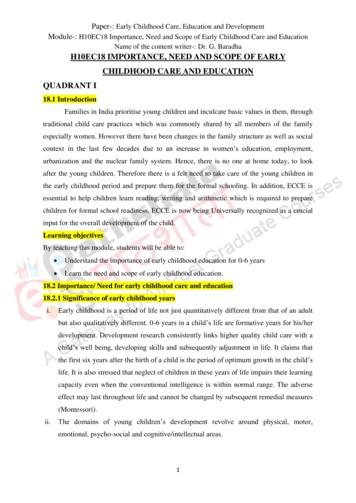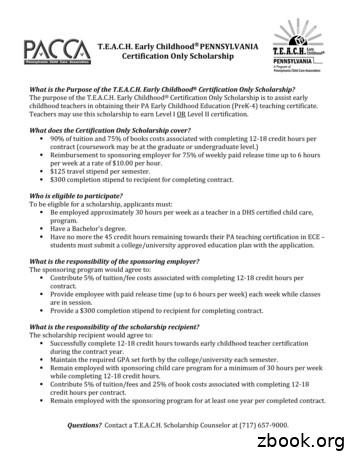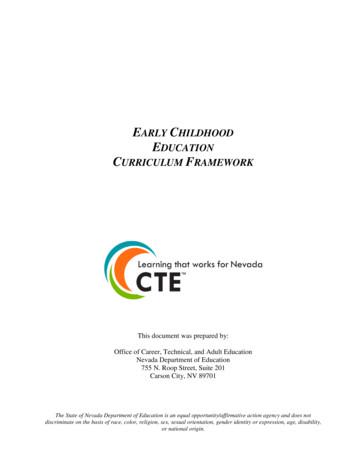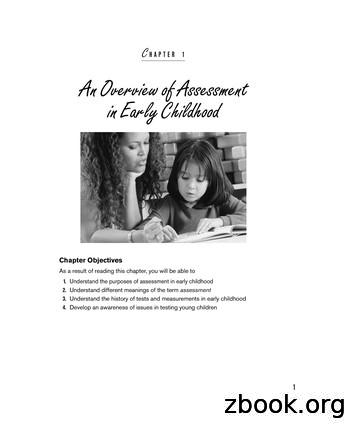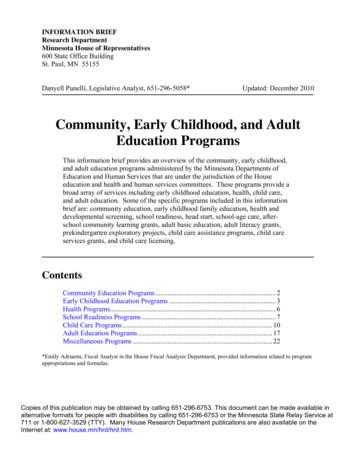Early Childhood Indicators Of Progress: Minnesota's Early .
EARLYCHILDHOODINDICATORSOF PROGRESS: Minnesota’s Early Learning Standards2005FAMILY MEMBERSTEACHERS AND CAREGIVERSCOMMUNITY MEMBERSPOLICYMAKERSA framework for understandingand communicating a common setof developmentally appropriateexpectations for children in thepreschool period of ages three tofive, presented within a context ofshared responsibility andaccountability for helping childrenmeet these expectations
BACKGROUND AND ACKNOWLEDGEMENTSThe Early Childhood Indicators of Progress: Minnesota's Early Learning Standards (2005) is a projectof the Minnesota Department of Education (MDE) and the Minnesota Department of Human Services(DHS). The first edition was printed under the title Minnesota Early Childhood Indicators of Progress: AResource Guide in 2000 by the former Minnesota Department of Children, Families & Learning. AnEarly Childhood Indicators of Progress Task Force that included early childhood practitioners andmembers of the Minnesota Association for the Education of Young Children (MNAEYC) and the Minnesota Association of Early Childhood Teacher Educators (MAECTE) developed it. It was widelyreviewed at that time by many individuals representing a diversity of early childhood education andcare programs.This 2005 revision was drafted by an interagency committee working with early childhood consultantGail Roberts and included:Lisa Backer, MDE, Early Childhood Special EducationKaren Carlson, MDE, Early Learning ServicesBetty Cooke, MDE, Early Childhood Education/Early Childhood Family EducationJoAnn Enos, DHS, Child Development ServicesBarbara O'Sullivan, MDE, Early Childhood Education/School ReadinessDebbykay Peterson, MDE, Early Childhood Screening/KindergartenSandy Simar, MDE, Head Start CollaborationDeb Swenson-Klatt, DHS, Child Development ServicesNancy Wallace, early childhood education consultant and author of the first edition/St. Francis PublicSchoolsThe following members of the original Early Childhood Indicators of Progress Task Force received therevised draft to review:Sharon Bahe, St. Paul Public SchoolsSandra Benson, St. Francis Public SchoolsDenise Bryant, Child CareMarilee Christensen-Adams, Anoka-Hennepin Public SchoolsLois Engstrom, MDE, RetiredLinda Frost, Mankato Public SchoolsLynn Galle, University of Minnesota, Twin CitiesDan Gartrell, Bemidji State UniversitySharon Henry-Blythe, Greater Minneapolis Day Care AssociationMary Jo Hensel, Lake Crystal-Wellcome Memorial School DistrictGretchen Irvine, Augsburg CollegeMargie McMahon, White Bear Lake Public SchoolsNancy Penn, St. Peter Public SchoolsAnita Segador Beaton, Metropolitan State UniversityMelissa Shamblott, St. Paul Public SchoolsKathy Simonson, Elk River Public SchoolsVicki Thrasher Cronin, Ready4KThe revised draft was also provided electronically for review and feedback on statewide list servesreaching hundreds of administrators, teachers, and caregivers in the following Minnesota early childhood education and care programs:Child Care Centers/Family Child Care/Tribal Child CareChild Care Resource and ReferralEarly Childhood Family EducationEarly Childhood ScreeningEarly Childhood Special Education/Part CHead StartSchool ReadinessMembers of MNAEYC and MAECTE also reviewed it, and MNAEYC passed a resolution in supportof it.Feedback was carefully reviewed by the interagency committee and incorporated into this final edition.The support and contributions of members from the early childhood education associations, staff fromearly childhood education and care programs, and many others who reviewed and provided feedbackon this document are gratefully acknowledged.
EARLYCHILDHOODINDICATORSOF PROGRESS:Minnesota’s Early Learning StandardsTABLE OF CONTENTSIntroductionPotential UsesOrganization and Structure of DocumentEarly Childhood Indicators of Progress Domain FrameworkSocial and Emotional DevelopmentEmotional DevelopmentSelf-ConceptSocial Competence and RelationshipsApproaches to LearningCuriosityRisk-TakingImagination and InventionPersistenceReflection and InterpretationLanguage and Literacy DevelopmentListeningSpeakingEmergent ReadingEmergent WritingCreativity and the ArtsCreatingRespondingEvaluatingCognitive DevelopmentMathematical and Logical ThinkingScientific Thinking and Problem-SolvingSocial Systems UnderstandingPhysical and Motor DevelopmentGross Motor DevelopmentFine Motor DevelopmentPhysical Health and Well-BeingEarly Childhood Indicators of Progress: Minnesota’s EarlyLearning StandardsReference ListAdditional 0424344464849505254555860
EARLYCHILDHOODINDICATORSOF PROGRESS:Minnesota’s Early Learning StandardsPURPOSEThe primary purpose of this document is to provide a framework forunderstanding and communicating acommon set of developmentallyappropriate expectations for youngchildren within a context of sharedresponsibility and accountability forhelping children meet these expectations.The document was developed withfive goals in mind:INTRODUCTIONA large and growing body of researchsupports the critical relationshipbetween early childhood experiencesand successful learning outcomes.The responsibility for providing support systems and resources thatresult in positive outcomes for youngchildren is a shared one. Families,early childhood teachers and caregivers, community members, and policymakers all contribute to the wellbeing of children.The Early Childhood Indicators ofProgress document recognizes theimportance of this shared responsibility and accountability in order toachieve positive outcomes for children. This document stresses theimportance of collective efforts amongfamilies, early childhood educationand care, communities, and policymakers in supporting the learning anddevelopment of children. The effortsof each and every one of thesegroups are vital in the process ofdeveloping healthy, well-functioningchildren.11. To increase understanding of allareas of a child's developmentand to recommend strategies forsupporting optimum development.2. To expand understanding of themultiple influences on theeducation and life success ofyoung children.3. To support families by providingexamples of strategies thatfacilitate and enhance children'sdevelopment.4. To provide teachers, caregivers,and administrators in earlychildhood education and careprograms and settings with acommon conceptual frameworkand guidelines for planningcurriculum, instruction, andassessment of young children.5. To provide a resource forcommunity members andpolicymakers to use in assessingthe impact of current policies andresources on the optimaldevelopment of young children.
These goals are consistent withreports from several national groupsstudying the development of statelevel early learning standards(NAEYC & NAECS/SDE, 2002; ScottLittle, Kagan, & Frelow, 2003a;Shore, Bodrova, & Leong, 2004).Early learning standards expressshared expectations for young children's learning and provide a common language for measuringprogress toward achieving thesegoals (Kendall, 2003; Kagan & ScottLittle, 2004). Research emphasizesthe importance of brain developmentand the early years for later development and learning (Shonkoff &Phillips, 2000; Hyson, 2003).Researchers have concluded that"Young children are more capablelearners than current practices reflect,and good educational experiences inthe preschool years can have a positive impact on school learning" (Bowman, Donovan, & Burns, 2000, p.2).ORGANIZATIONAND STRUCTUREThe Early Childhood Indicators ofProgress document is divided into sixdomains that reflect the full range ofchild development as recommendedby national guidelines (Kagan, Moore,& Bredekamp, 1995):Social and EmotionalDevelopmentApproaches to LearningLanguage and LiteracyDevelopmentCreativity and the ArtsCognitive DevelopmentPhysical and Motor DevelopmentEach domain is further divided intothree to five components thatdesignate areas of children'sdevelopment within each domain.Indicators of children's progress ingaining concepts, knowledge, andskills within each componentare then specified.The Early Childhood Indicators ofProgress were initially written in 2000and have been systematicallyreviewed and revised using recentlydeveloped guidelines related to childoutcome standards (NAEYC &NAECS/SDE, 2002; Shore, Bodrova,& Leong, 2004). The following criteria,based on national reviews (Scott-Little, Kagan, & Frelow, 2003b, 2003c;Neuman & Roskos, 2004), were usedfor the inclusion of specific indicators:1. Research-based - Indicators arereasonably achievable and ageappropriate.2. Clearly written - Indicators areclear and coherent as to whatpreschool-age children shouldknow and be able to do.3. Measurable - Indicators reflectobservable behaviors, concepts,and skills.4. Comprehensive - Indicatorscover all domains of developmentand provide sufficient breadthand depth of each area ofdevelopment.5. Manageable - There are areasonable number of indicators ineach domain to comprehend.6. Applicable - Indicators arebroadly applicable to children fromdiverse linguistic, economic, andcultural backgrounds and tochildren with variations indevelopmental needs and abilitiesin different early childhood settings.Strategies that family members andteachers and caregivers in earlychildhood education and care programs and settings can use to facilitate children's development are listedfor each component. The strategiesfor family members and teachers andcaregivers are not intended to be allinclusive, but rather provide suggested learning activities to enhancechildren's development.Strategies community members andpolicymakers can use to promote andsupport children's development arealso included for each domain. Thesestrategies for community membersand policymakers are repeated foreach component within a domain.THE EARLY CHILDHOODDEVELOPMENTAL PERIODThe early childhood period of growthand development spans the yearsfrom birth to age eight (Bredekamp &Copple, 1997). The Early ChildhoodIndicators of Progress are intendedas a guide for children in the preschool period of ages three to five.The indicators are based on widelyheld developmental expectationsobserved in a child at approximatelyfour years of age. It is expected thatmost children will meet the majority ofthese expectations by the end of thepre-kindergarten year. Because normal development varies greatly fromchild to child, the Early ChildhoodIndicators of Progress document isintended to be used as a flexibleguide in describing a child's individualprogress.Child development progresses differently for every individual child. Children are influenced by their distinctexperiences with the diverse valuesand practices of their family, their culture, and their community (NationalAssociation for the Education ofYoung Children, 1996). For thesereasons, although children develop ingenerally similar stages, their individual life experiences are reflected ingreatly diverse patterns of behaviorand learning. Such individual differences are normal and must berespected in order for children tomaintain a sense of self-worth.2
A NEW APPROACHThe Early Childhood Indicators ofProgress are written intentionally toinclude both typically and atypicallydeveloping children. Children with disabilities will make progress on theknowledge, concepts, and skills thatare described by the indicators, withexpected variations for each child.Recommendations for serving children with special needs in inclusiveearly childhood settings are reflectedin the suggested learning strategies(Sandall, McLean, & Smith, 2000).The development of Minnesota'sEarly Childhood Indicators ofProgress was informed by the following Guiding Principles, which arebased on child developmentresearch:Young children are capableand competent.Development occurs inpredictable patterns.Children are individuals whodevelop at different rates.Many factors influence a child'sdevelopment.Children exhibit a range of skillsand competencies within anydomain of development.Expectations for children must beguided by knowledge of childgrowth and development.Young children learn through play,interaction with others, and activeexploration of their environment.Families are children's first andmost important caregivers andeducators.3The Early Childhood Indicators ofProgress: Minnesota's Early LearningStandards provide a unique approachin the movement toward increasedaccountability. Especially at the earlychildhood level, children's development must be considered within thecontext of the family, early childhoodeducation and care, and the community. These systems, along with policymakers, share a role in beingaccountable for the optimal development of young children. The EarlyChildhood Indicators of Progressunderscore the importance of sharedresponsibility and shared accountability for optimal development in termsof both learning opportunities andoutcomes for children. By emphasizing the necessity for collaborationamong families, early childhood education and care, communities, andpolicymakers, this document suggests that everyone must worktogether. This must be done in aninterdependent way if all children areto have optimal opportunities forlearning and development. Underlyingthis work is the belief that only whenall stakeholders are both individuallyand collectively responsible andaccountable for the learning anddevelopment of young children will allof Minnesota's children experienceand achieve success.
EARLYCHILDHOODINDICATORSOF PROGRESS:Minnesota’s EarlyLearning StandardsPOTENTIAL USESThe Early Childhood Indicators ofProgress: Minnesota's Early LearningStandards is to be used as a resourcefor family members, teachers andcaregivers, community members, andpolicymakers in ways that are supportive of young children's development. Since the publication of the firstedition in 2000, many individuals andgroups from across the state haveused the indicator document in manyof the ways described in this section.4
TO BUILD AWARENESSOF THE SYSTEMS NEEDEDTO SUPPORT THE GROWTH ANDDEVELOPMENT OF CHILDRENParents are the best advocates fortheir children. This document can beused to make concrete connectionsbetween actions by people and thequality of life for children and families.Parents can use strategies listed inthis document to offer suggestionsand promote various projects andactivities within their communities.The document can also provide guidance to parents about what to look foras they choose programs for theiryoung children.FOR FAMILY MEMBERSTO BUILD AWARENESS OFCHILD DEVELOPMENTThe Early Childhood Indicators ofProgress can be used to help parentsdevelop new ways of viewing theirchild's development. Many teachersand caregivers have summarized oradapted sections of the document foruse with parents and family members.One way this has been done is todevelop a series of parent tip cards forspecific domains with an emphasis onthe strategies family members canuse to support their child's development (Minnesota Department ofEducation, 2004b).5TO INVOLVE FAMILIESIN LEARNINGA high level of family involvement isan indicator of a high quality program.Children benefit when family membersare invited to participate in ongoingcommunication about what is happening in their child's early childhood education and care through discussionswith caregivers, parent-teacher conferences, open houses, parent-childactivity times, parent education, transition-to-kindergarten sessions, and volunteer opportunities. Informationabout widely held developmentalexpectations can be shared with parents during these times (Meisels,Marsden, & Stetson, 2000). Familieswho are engaged in their child's education are better able to support theirchild's learning and development(Mueller, 2003).FOR TEACHERSAND CAREGIVERSTO GUIDE PLANNINGFOR CURRICULUM CONTENTAND TEACHING STRATEGIESThe Early Childhood Indicators ofProgress provide a common framework for developmentally appropriateexpectations for children who areapproximately four years of age. It isexpected that most children willaccomplish the majority of the indicators by the end of the pre-kindergartenyear. In order to meet this expectation,the indicators can be used as a guidefor planning curriculum content andteaching strategies for children in thepreschool period of ages three to five.The indicators provide a common language for use across programs. Acommon language and frameworkfacilitates discussion and collaborationamong home visitors, home-basedcaregivers, school and center-basedstaff, and others. The domains andindicators included are consistent withthe national Head Start Child Outcomes Framework (Head StartBureau, 2003). The use of the indicators can help programs align curriculum, instruction, and assessment withboth state and national outcome standards and guidelines (NAEYC &NAECS/SDE, 2003).
Individual teachers and caregiverscan develop curriculum with the indicators in mind and plan assessmentappropriate to their setting and relatedto the indicators. Teachers and caregivers can focus their curriculum onsignificant learning experiences tosupport the concepts, knowledge, andskills described by the indicators. Inthis way, teachers and caregivers arenot locked into a set curriculum, butrather can design activities within particular domains that will give childrenopportunities to practice the concepts,knowledge, and skills identified by theindicators.Each child's culture and languagebackground, developmental level,learning style, and personal interestsmust be taken into account as learning experiences are implemented(Bredekamp & Rosegrant, 1992; Copple, 2003). This approach to curriculum supports exploration, innovation,and individualization within a settingas opposed to a prescribed curriculum(Bredekamp & Rosegrant, 1995). Theframework promotes diversity andequity in terms of what children do,how children show what they know,and what constitutes success.TO PROVIDE DIRECTIONFOR AUTHENTIC ASSESSMENTOF YOUNG CHILDRENThe indicators can help teachers andcaregivers define the kinds of thingsyoung children need to know and beable to do. Once those are articulated,teachers and caregivers need to consider how to collect evidence of children's learning through authenticassessment.Authentic assessment practices arethose that are based on everydaylearning experiences, provide for actual child performance, and involve children in the evaluation process(NAEYC & NAECS/SDE, 2003; Santos, 2004; McAfee, Leong, & Bodrova,2004). Authentic assessment methodsfor children should meet these criteria:Fair to all cultures, languagegroups, and developmental levelsReflect real-world classroom orfamily contextsTied to children's daily activitiesand assess children's actualperformanceDone in natural settings andsituations that are non-threateningto the childInclusive of families and responsiveto cultural and linguistic variationsUse multiple sources of informationon multiple occasionsInsure continuity and consistencyover timeSupported by ongoing professionaldevelopment to ensure skilledobservation and assessmentIn addition, assessment should bringabout benefits for children, be connected to specific purposes, and valueparents as sources and audiences forassessment (Shepard, Kagan, &Wurtz, 1998).Components of authentic assessmentinclude: observation, observationchecklists, rating scales, portfolios,and summary reports. These components may be used individually or incombination depending upon thedesired purposes of the assessmentinformation. Observation includes thegathering and recording of informationby noting facts or occurrences of children's skills, abilities, and behaviors(Jablon, Dombro, & Dichtelmiller,1999). Observational checklists, whencombined with observation notes andsamples of children's work, providereliable ways to understand growthand development of skills and behaviors over time (Helm, Beneke, &Steinheimer, 1998).One of the primary purposes ofassessment is to inform instructionand help teachers and caregiversmake decisions concerning children'ssubsequent learning experiences. Inthat way, a continuous cycle of planning, implementing, and evaluatingchildren's learning experiences helpsensure that children are challengedappropriately to develop the concepts,knoweldge, and skills needed to reachtheir full potential.Examples of authentic assessmentsinclude the Work Sampling System ofChild Assessment, the Child Observation Record, and the Creative Curriculum Assessment System. The WorkSampling System is a curriculumembedded, teacher-guided assessment that emphasizes the collection ofmultiple sources of documentationover time. The system involves thechild, family, teacher, or caregiver inthe ongoing process of assessmentand reporting (Meisels & Atkins-Burnett, 2002; Dichtelmiller, Jablon, Dorfman, Marsden, & Meisels, 2001).The Child Observation Record (COR)evaluates children's behavior duringnormal learning activities and assesses broad areas of child development.Teachers and caregivers use theobservational records to report to families and to create individual plans forchildren (Schweinhart, 1993;High/Scope, 1992).The Creative Curriculum approachuses an assessment that includesteacher or caregiver observations anda checklist based on a developmentalcontinuum. This approach emphasizes the integration of curriculum andassessment through teacher or caregiver planning and implementation.Parents are involved through conferences and the sharing of reports(Dodge, Colker, & Heroman, 2002).TO PROVIDE A FRAMEWORKFOR PROGRAM STANDARDSAND PROGRAM EVALUATIONStaff within early childhood educationand care programs and settings canuse the Early Childhood Indicators ofProgress to frame questions for meeting program standards and conducting program evaluation. High qualityprogramming provides opportunitiesthat support each child's developmental stage and need to engage in play,exploration, and active learning.6
A first set of questions centers on thetypes of resources, activities, andlearning experiences provided. Therequirements for the services childrenreceive are generally referred to asprogram standards. Program standards provide criteria for importantprogram features such as adult-childratios, group sizes, teacher or caregiver qualifications, and curriculum(Scott-Little, Kagan, & Frelow, 2003a).Four major variables that impactdesired program outcomes are thelearning environment, interpersonalrelationships, daily schedules and routine, and materials and activities(Harms, Clifford, & Cryer, 1998).These components interact to supportthe desired learning opportunities andoutcomes for children. The best programming considers all of these variables when planning, teaching, andevaluating effectiveness.The Head Start Program PerformanceStandards provide a sound foundationfor achieving positive child outcomes(Head Start Bureau, 2004). The HeadStart Program Performance Standards provide for all aspects of earlychildhood development, health services, family and community partnerships, and program design and management. Child outcome informationfor groups of children becomes part ofthe data used to determine how wellprograms are doing in meeting overallgoals and objectives.7Accreditation processes such asthose established by the NationalAssociation for the Education ofYoung Children (NAEYC) and theNational Association of Family ChildCare (NAFCC) help assure that highquality standards are present. TheNAEYC program standards specifyten areas for program evaluation:relationships, curriculum, teaching,assessment, health, teachers, familyinvolvement, community partnerships, physical environment, andleadership and management(National Association for the Education of Young Children, 2004). Specific indicators in each of these tenareas are assessed as part of theaccreditation procedures. TheNAFCC process sets and assessesstandards for health, safety, andpersonal and professional development for family child care providers(National Association of FamilyChild Care, 1999).A second set of questions aboutprogram evaluation focuses on theactions staff take as they interactwith other groups and programswithin the community. Theseinquiries lead to information aboutlinkages to other agencies orprograms and the development ofcommon goals and expectations forchildren in the community.TO PROVIDE IDEASFOR STAFF TRAININGAND DEVELOPMENTTeachers and caregivers can benefitnot only from a concise frameworkof child development as provided inthis document, but also from anunderstanding of how what they doin early childhood settings impactschild outcomes and school readiness. A related document, Minnesota Core Competencies, defines corecompetencies for teachers and caregivers who work with young children(Minnesota Association for the Education of Young Children, 2004).The Core Competencies describeexpectations for what the adults who
work with young children need toknow and be able to do, similar tothe way these early learning standards, the Early Childhood Indicators of Progress, describe expectations for what young children needto know and be able to do. Teachersand caregivers can identify anynumber of areas in the Early Childhood Indicators of Progress andCore Competencies documentswhere they may need further information and training. Some of theseareas could include authenticassessment, curriculum development, teaching strategies and bestpractices in instruction, and programevaluation. They might also includeadvocacy with the community andwith policymakers, communicationwith parents, and parent educationand involvement.Many of the institutions of highereducation in Minnesota also use theEarly Childhood Indicators ofProgress to help ensure that teachers and caregivers enrolled in earlychildhood education and relatedcourses understand these widelyheld developmental expectations foryoung children and the implicationsfor curriculum, instruction, andassessment.FOR COMMUNITYMEMBERSTO PROVIDE A FRAMEWORKFOR NEEDS ASSESSMENTWITHIN THE COMMUNITYThe Early Childhood Indicators ofProgress can serve as a guide foridentifying the sources of supportwithin the community that encourage the healthy growth and development of young children. Communityresources such as early childhoodcenters, family child care homes,playgrounds, libraries, recreationalcenters, and elementary schools allwork together to contribute to children's development (National Association of State Boards of Education,1991).Business leaders and employers arekey players in helping communitiesfocus on the importance of earlychildhood education and care for thefuture economic development of thecommunity (Committee for Economic Development Research and Policy Committee, 2002; Rolnick &Grunewald, 2003). Communitymembers can also use county-bycounty information on key indicatorsto assess how well their local community is doing in providing opportunities for the healthy development ofyoung children (Kids Count, 2004).TO HELP ORGANIZEADVOCACY EFFORTSWITHIN THE COMMUNITYThis document can be useful inhelping various groups see the continuity of their efforts across homeand program settings where thereare young children. This documentprovides concrete connectionsbetween healthy child developmentand access to resources within thecommunity. Community membersand policymakers can help assurethe optimal learning and development of young children by making acommitment to support early childhood education and care efforts(Child Trends, 2001; Committee forEconomic Development Researchand Policy Committee, 2002). Communities can support and strengthenthe resources available to supportfamilies with young children andbuild stronger connections amongthe various programs and servicesthat impact children's lives.FOR POLICYMAKERSTO ASSESS THE IMPACTOF PUBLIC POLICIESON YOUNG CHILDRENAND THEIR FAMILIESPolicymakers can use the EarlyChildhood Indicators of Progress asa reference for assessing the impactof policy decisions on the lives ofchildren and their families. By providing consistent and reliable support and resources to families, alarger proportion of families withyoung children can participate inopportunities that enhance learningand development. Prevention andearly intervention efforts to makesure that all children get a strongand healthy start help reduce thelikelihood that children will needmore intensive and costly help at alater age (Sandall, McLean, &Smith, 2000; Rolnick & Grunewald,2003).There are a number of ways toassess public policies and impacts.State-level evaluation studies haveassessed the readiness of childrenfor school (Minnesota Department ofEducation, 2003 & 2004a). Otherapproaches provide ongoingassessment, such as the state-bystate profiles of child well-being prepared annually and reported in theKids Count Data Book (Annie E.Casey Foundation, 2004).8
TO IMPROVE PUBLICUNDERSTANDING OFAPPROPRIATE EXPECTATIONS,ACCOUNTABILITY,AND RESPONSIBILITYThe Early Childhood Indicators ofProgress enhance understanding ofwidely held developmental expectations for young children from three tofive years of age, along with the typesof activities that provide meaningfullearning experiences. Appropriateways of documenting and assessingthe performance and progress ofyoung children should also be considered (Shore, Bodrova, & Leong,2004). The document provides acomprehensive framework for sharedaccountability and responsibility forchildren's development.CONCLUSIONBecause a child's first and mostimportant learning occurs in the context of the family, it is essential thatfamilies have the supports andresources needed to help their children develop in optimal ways. Families are better able to care for, nurture,and help their children succeed ifearly childhood teachers and caregivers, community members, and policymakers share in the collective commitment to foster healthy developmentof all young children.9
EARLYCHILDHOODINDICATORSOF PROGRESS:Minnesota’s Early Learning StandardsOrganization and Structureof DocumentThe Early Childhood Indicators of Progress: Mi
BACKGROUND AND ACKNOWLEDGEMENTS The Early Childhood Indicators of Progress: Minnesota's Early Learning Standards(2005) is a project of the Minnesota Department of Education (MDE) and the Minnesota Department of Human Services (DHS). The first edition was printed under the title Minnesota Early Childhood Indicators of P
Understand the importance of early childhood education for 0-6 years Learn the need and scope of early childhood education. 18.2 Importance/ Need for early childhood care and education 18.2.1 Significance of early childhood years i. Early childhood is a period of life not just quantitatively different from that of an adult
T.E.A.C.H. Early Childhoodâ PENNSYLVANIA Certification Only Scholarship What is the Purpose of the T.E.A.C.H. Early Childhood Certification Only Scholarship? The purpose of the T.E.A.C.H. Early Childhood Certification Only Scholarship is to assist early childhood teachers in obtaining their PA Early Childhood Education (PreK-4) teaching certificate.
Early Childhood Education I L1 Early Childhood Education II L2 Early Childhood Education III L3C Early Childhood Education Advanced Studies AS The core course sequencing with the complementary courses provided in the following table serves as a guide to schools for their programs of study.
CHAPTER 1 An Overview of Assessment in Early Childhood Understanding Assessment in Infancy and Early Childhood Not too long ago, resources on early childhood assessment were limited to occa-sional articles in journals, chapters in textbooks on teaching in early childhood pro-grams, and a few small textbooks that were used as secondary texts in .
ECE 240 - Administration of Early Childhood Care and Education Programs (3) ECE 241 - Administration: Human Relations for Early Childhood Education (3) Colorado Mesa University B.A. Early Childhood Education - Early Childhood Special Education Advisor: Vail Shoultz-McCole vshoultz@coloradomesa.edu 970-255-2674
Early Childhood Care, Development and Education (ECCDE) is a term that is used interchangeably worldwide but refers to the same concept of early childhood education and cognitive development. The World Bank for instance refers to it as Early Childhood Care and Education, whereas UNESCO refers to it as Early Childhood Development Care.
streams for early childhood and child care programs, making recommendations on how to coordinate and collocate early childhood and child care programs in one State Office of Early Learning, and reviewing program evaluations regarding high-quality early childhood programs. (Minn. Stat. § 124D.141)
Business Administration professionals undertake a wide range of complex tasks in a variety of work contexts. They have a high degree of autonomy and responsibility and may provide some supervisory support (particularly at SCQF Level 8). Job titles for Business Administration apprentices could include:

